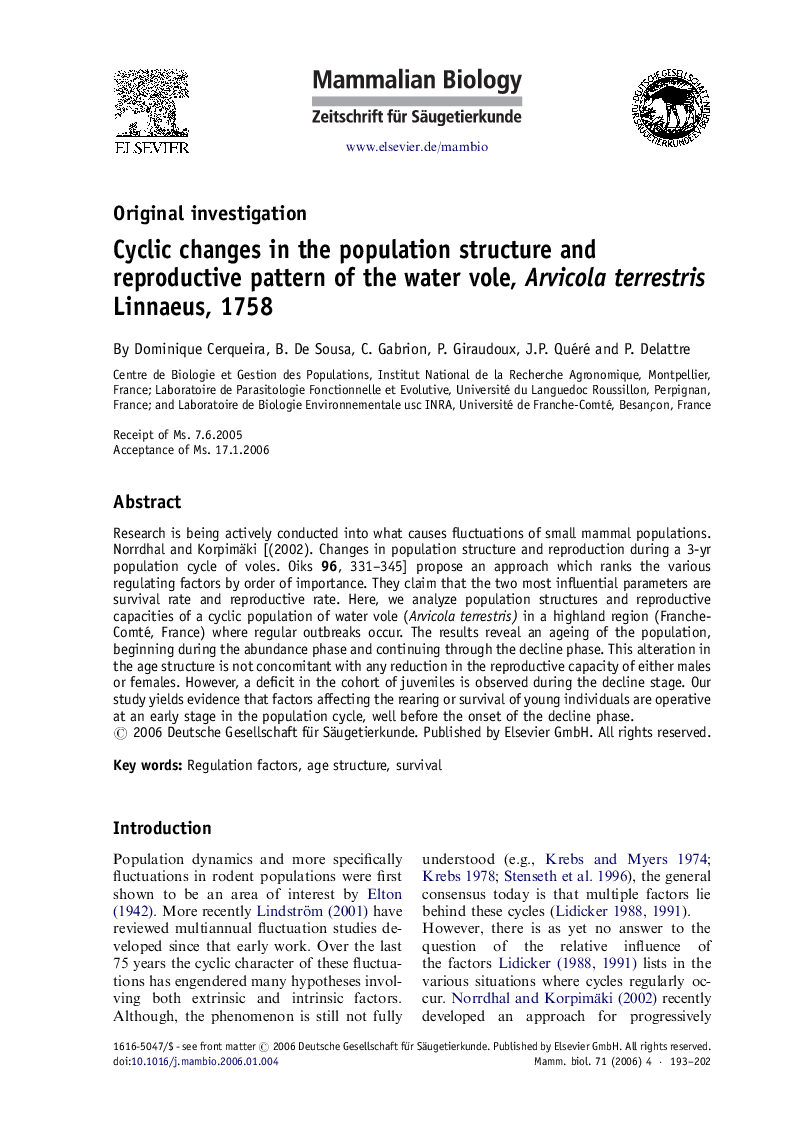| کد مقاله | کد نشریه | سال انتشار | مقاله انگلیسی | نسخه تمام متن |
|---|---|---|---|---|
| 2194339 | 1098433 | 2006 | 10 صفحه PDF | دانلود رایگان |

Research is being actively conducted into what causes fluctuations of small mammal populations. Norrdhal and Korpimäki [(2002). Changes in population structure and reproduction during a 3-yr population cycle of voles. Oiks 96, 331–345] propose an approach which ranks the various regulating factors by order of importance. They claim that the two most influential parameters are survival rate and reproductive rate. Here, we analyze population structures and reproductive capacities of a cyclic population of water vole (Arvicola terrestris) in a highland region (Franche-Comté, France) where regular outbreaks occur. The results reveal an ageing of the population, beginning during the abundance phase and continuing through the decline phase. This alteration in the age structure is not concomitant with any reduction in the reproductive capacity of either males or females. However, a deficit in the cohort of juveniles is observed during the decline stage. Our study yields evidence that factors affecting the rearing or survival of young individuals are operative at an early stage in the population cycle, well before the onset of the decline phase.
ZusammenfassungZyklische Änderungen der Populationsstruktur und des Vermehrungsmusters von Schermäusen, Arvicola terrestris Linnaeus, 1758Mehrere gegenwärtige Studien forschen aktiv nach den Ursachen der Kleinsäugerpopulationsschwankungen. Norrdhal und Korpimäki (2002) erläutern ein Verfahren, in dem die verschiedenen Regulationsfaktoren ihrer Bedeutung nach eingeordnet werden. Diesen Autoren zufolge sind die zwei einflussreichsten Parameter die Überlebens- und die Vermehrungsraten. Unsere Arbeit hatte zum Ziel, diese Hypothese zu unterstützen, indem Populationsstrukturen und Vermehrungsvermögen einer zyklischen Schermauspopulation (Arvicola terrestris) in einem Berggebiet (Franche-Comté, Frankreich), in dem Ausbrüche regelmässig vorkommen, untersucht wurden. Die Ergebnisse weisen auf ein Altern der Population hin, das während der Abundanzphase begonnen hat, und sich in der Rückgangsphase fortsetzte. Diese Änderung in der Altersstruktur war von keiner Abnahme des Vermehrungsvermögens, weder der weiblichen, noch der männlichen Individuen, begleitet. Es wurde jedoch während der Rückgangsphase ein Defizit in der Jungtierkohorte beobachtet. Aus unserer Studie geht also hervor, dass kausale Faktoren auf das Aufzuchtsvermögen der Eltern oder auf die Lebensfähigkeit der Jungtiere schon früh im Populationszyklus einwirken, lange bevor die Rückgangsphase beginnt.
Journal: Mammalian Biology - Zeitschrift für Säugetierkunde - Volume 71, Issue 4, 22 July 2006, Pages 193–202